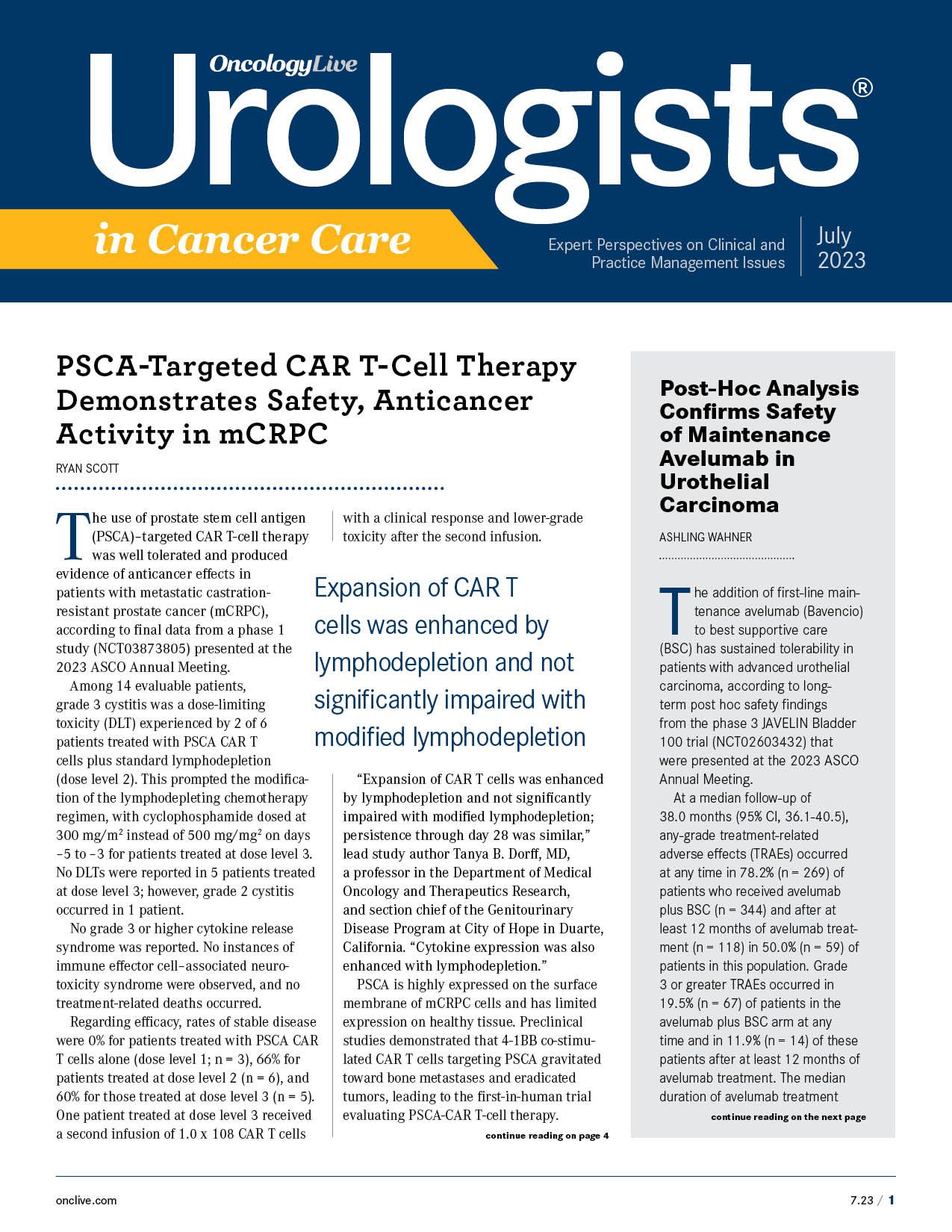Publication
Article
Special Issues
Lutetium Lu 177 Vipivotide Tetraxetan Provides HRQOL Benefit, Reduces Skeletal Events in mCRPC
Author(s):
The addition of lutetium Lu 177 vipivotide tetraxetan to standard-of-care treatment delayed time to worsening of health-related quality of life and skeletal events compared with standard of care alone for patients with metastatic castration-resistant prostate cancer.

The addition of lutetium Lu 177 vipivotide tetraxetan (Pluvicto; formerly 177Lu-PSMA-617) to standard-of-care treatment delayed time to worsening of health-related quality of life (HRQOL) and skeletal events compared with standard of care alone for patients with metastatic castration-resistant prostate cancer (mCRPC), according to findings from the phase 3 VISION trial (NCT03511664) published in Lancet Oncology.1
At the October 23, 2019, data cutoff patients who received lutetium Lu 177 vipivotide tetraxetan plus standard of care (n = 385) experienced a median time to first skeletal event or death was 11.5 months (95% CI, 10.3-13.2) compared with 6.8 months (95% CI, 5.2-8.5) in the standard-of-care group (n = 196; HR, 0.50; 95% CI, 0.40-0.62). Moreover, time to worsening by FACT-P (HR, 0.54; 95% CI, 0.45-0.66; P < .001), BPI-SF pain intensity score (HR, 0.52; 95% CI, 0.42-0.63; P < .001), and EQ-5D-5L utility score (HR, 0.65; 95% CI, 0.54-0.78; P < .001) all favored the combination arm vs standard of care.1
Lutetium Lu 177 vipivotide tetraxetan is a prostate specific membrane antigen (PSMA)-directed radioligand therapy that possess high tumor-to-tissue uptake. Previously published data from VISION showed that the agent plus standard of care offered a benefit vs standard of care alone in terms of median overall survival (OS; HR, 0.62; 95% CI, 0.52-0.74; 1-sided P < .001) and radiographic progression-free survival (rPFS; HR, 0.40; 99.2% CI, 0.29-0.57; 1-sided P < .001) among patients with advanced PSMA-positive mCRPC.2 Additional post-hoc survival and prostate-specific antigen level outcomes were reported at the 2022 ESMO Congress.3
The open-label, multicenter VISION trial is the first phase 3 study of lutetium Lu 177 vipivotide tetraxetan, enrolling adult patients with progressive mCRPC with an ECOG performance status of 2 or less. Eligible patients also needed to have a life expectancy of at least 6 months, had undergone treatment with 1 androgen receptor inhibitor and 1 or 2 taxane-containing regimens, and had adequate, hepatic, renal, and bone marrow function. Patients who were candidates for additional chemotherapy at the time of screening and those who required treatments not permitted under the study protocol were excluded.1
Patients were randomly assigned 2:1 to receive lutetium Lu 177 vipivotide tetraxetan plus standard of care or standard of care alone. Lutetium Lu 177 vipivotide tetraxetan was administered every 6 weeks for 4 cycles plus 2 optional additional cycles for patients who tolerated the agent and displayed evidence of response. A dose of lutetium Lu 177 vipivotide tetraxetan could be reduced or delayed for a maximum of 4 weeks. Standard of care therapies were selected by the investigator and included approved hormonal agents, bisphosphonates, and radiotherapy.
Patients were stratified by baseline lactate dehydrogenase concentration (≤ 260 IU/L vs > 260 IU/L), presence of liver metastases (yes vs no), ECOG performance status (0 to 1 vs 2), and if an androgen receptor inhibitor was included in standard of care (yes vs no). The coprimary end points were OS and rPFS. Key secondary end points included time to first symptomatic skeletal event, overall response rate, and disease control rate. Additional secondary end points included safety, HRQOL and pain outcomes, and PFS.
The median age was 71 years (range, 65-75) in the investigational arm vs 72 years (range, 66-76) in the control arm. Most patients in both arms were White (87% vs 85%) and the study dropout rates were 64% vs 78%, respectively.
Patients in the lutetium Lu 177 vipivotide tetraxetan and the standard-of-care arms completed the end-of-treatment FACT-P (49% vs 45%), BPI-SF (50% vs 46%), and EQ-5D-5L (50% vs 45%) questionnaires at similar rates.
Additional findings from the trial showed that most patients in both the investigational and control arms experienced a symptomatic skeletal event or death, at rates of 66% vs 70%, respectively. Symptomatic skeletal events (16% vs 17%) included radiation to relieve bone pain (11% vs 11%), symptomatic pathological bone fracture (3% vs 1%), spinal cord compression (1% vs 6%), and tumor-related orthopedic surgical intervention (< 1% vs 1%). The median follow-up times were 17.0 months (range 15.9-17.3) and 16.9 months (range, 11.5-not estimable [NE]), respectively, and the median time to events were 11.5 (range, 10.3-13.2) and 6.8 (range, 5.2-8.5). Patients experienced a benefit in terms of skeletal events with the addition of lutetium Lu 177 vipivotide tetraxetan to standard of care whether they received a bone-targeted agents (HR, 0.49; 95% CI, 0.36-0.68) or not (HR, 0.50; 95% CI, 0.37-0.68).
In the post-hoc analyses, FACT-P total score (HR, 0.46; 95% CI, 0.35-0.61), BPI-SF pain intensity (HR, 0.45; 95% CI, 0.33-0.60), and EQ-5D-5L utility score (HR, 0.49; 95% CI, 0.40-0.62) all favored the investigational arm. In the investigational and control arms, respectively, the median follow-up time for FACT-P score was 4.4 months (range, 1.02-8.80) vs 0.76 months (range, 0.15-2.71). The median time to follow-up for BPI-SF pain intensity scale was 4.14 months (range, 1.64-8.77) vs 0.66 months (range, 0.20-2.56), respectively.
In terms of safety, the median follow-up was 14.78 months (range, 9.10-19.35) and 10.64 months (range, 5.09-17.22) in the investigational (n = 529) and control (n = 205) arms, respectively. The most common any-grade adverse effects (AEs) included fatigue (43% vs 23%), dry mouth (39% vs < 1%), nausea (35% vs 17%), anemia (32% vs 13%), back pain (23% vs 15%), arthralgia (22% vs 13%), and decreased appetite (21% vs 15%). Grade 3 or 4 hematologic AEs consisted of decreased hemoglobin (15% vs 6%), decreased lymphocyte counts (51% vs 19%) and decreased platelet counts (9% vs 2%). Treatment-related AEs leading to death were reported in no patients in the control arm and 5% of patients in the investigational arm. Events leading to death included pancytopenia (n = 2), bone marrow failure (n = 1), subdural hematoma (n = 1), and intracranial hemorrhage (n = 1).
Study authors concluded: “Treatment with lutetium Lu 177 vipivotide tetraxetan plus standard of care delayed rPFS and extended OS in patients with mCRPC and was associated with a longer period without deterioration in patient-reported HRQOL and pain than seen with standard of care alone. Low rates of hematological and renal toxicity were observed with lutetium Lu 177 vipivotide tetraxetan. These findings strengthen the rationale for use of lutetium Lu 177 vipivotide tetraxetan as a treatment option in patients with mCRPC who received previous androgen receptor pathway inhibitor and taxane treatment.”
References
- Fizazi K, Herrmann K, Krause BJ, et al. Health-related quality of life and pain outcomes with [177Lu]Lu-PSMA-617 plus standard of care versus standard of care in patients with metastatic castration-resistant prostate cancer (VISION): a multicentre, open-label, randomised, phase 3 trial. Lancet Oncol. 2023;24(6):597-610. doi:10.1016/S1470-2045(23)00158-4
- Novartis 177Lu-PSMA-617 significantly improves overall survival and radiographic progression-free survival for men with metastatic castration-resistant prostate cancer in phase III VISION study. News release. Novartis. June 3, 2021. Accessed June 26, 2023. https://www.novartis.com/news/media-releases/novartis-177lu-psma-617-significantly-improves-overall-survival-and-radiographic-progression-free-survival-men-metastatic-castration-resistant-prostate-cancer-phase-iii-vision-study
- Armstrong AJ, Sartor O, Saad F, et al. Association between prostate-specific antigen decline and clinical outcomes in patients with metastatic castration-resistant prostate cancer in the VISION trial. Ann Oncol. 2022;33(suppl 7):S616-S652. doi:10.1016/annonc/annonc1070























%20(2)%201-Recovered-Recovered-Recovered-Recovered-Recovered-Recovered-Recovered-Recovered-Recovered-Recovered-Recovered-Recovered-Recovered-Recovered-Recovered-Recovered-Recovered.jpg?fit=crop&auto=format)
%20(2)%201-Recovered-Recovered-Recovered-Recovered-Recovered-Recovered-Recovered-Recovered-Recovered-Recovered-Recovered-Recovered-Recovered-Recovered-Recovered-Recovered-Recovered.jpg?fit=crop&auto=format)
